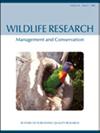Factors influencing the adaptability and habitat use of rescued Malayan sun bears (Helarctos malayanus) released in Peninsular Malaysia
IF 1.6
3区 生物学
Q3 ECOLOGY
引用次数: 0
Abstract
Abstract Context. The lack of documentation and detailed assessment of previous sun bear (Helarctos malayanus) release programs raises concerns about bears’ capacity to adapt to their new habitats and key elements of release success. AimsWe evaluated the influence of the sun bears’ individual profiles and environmental factors on their adaptability, and investigated their habitat use and movements in the wild. Methods. We released 13 rescued sun bears (four wild-caught and nine rehabilitated) to natural habitats between December 2015 and August 2017, and inferred adaptability process by analysing their pre- and post-release data. Key results. Post-release monitoring showed that sun bears required at least a month to acclimatise to their release area. No nuisance cases were reported, and bears were observed avoiding monitoring teams in a series of encounters. Principal-component analysis identified a previous history of ill health (e.g. malnutrition), low avoidance of humans prior to release and low potential of release sites as significant factors associated with poor adaptability of released bears. Rehabilitated bears also showed lower adaptability to hilly topography with an average elevation of more than 500 m. Individual profiles of adult physically fit wild-caught bears with high avoidance of humans prior to release were associated with high adaptability. Binary logistic regression indicated that habitat type was the main factor influencing bear movement. Bears had a high affinity for oil palm plantations adjacent to the forest edge. Most habitat use of released bears was close to the forest edge. Conclusions. In terms of competition, predation, food availability, and adaptability, the selection of forest edges adjacent to other favourable habitats is perceived as a more opportunistic survival strategy, as long as the bears do not rely on humans to survive and endure with the natural interactions in the wild. Implications. This study emphasises the importance of improving the likelihood of survival of rehabilitated bears, especially in the early release phase. Reducing human–bear interaction in rehabilitation centres by practising a buddy system and minimal human contact in captivity considerably enhances release effectiveness.马来西亚半岛获救马来熊(Helarctos malayanus)的适应性和栖息地利用的影响因素
抽象的上下文。以往马来熊(Helarctos malayanus)放生计划缺乏文件和详细评估,引发了人们对熊适应新栖息地的能力和放生成功的关键因素的担忧。目的评价马来熊个体形态和环境因素对其适应能力的影响,研究马来熊的生境利用和野外活动。方法。2015年12月至2017年8月,我们将13只获救的马来熊(4只野生捕获,9只康复)放归自然栖息地,并通过分析放归前后的数据推断其适应过程。关键的结果。放生后的监测显示,马来熊至少需要一个月的时间来适应放生区。没有报告滋扰案件,并观察到熊在一系列遭遇中避开监测小组。主成分分析确定,以往健康状况不佳(如营养不良)、放生前对人类的躲避程度低以及放生地点的潜力低,是与放生熊适应性差相关的重要因素。恢复后的熊对平均海拔超过500 m的丘陵地形的适应性也较差。在释放前高度回避人类的成年野生捕获熊的个体特征与高适应性相关。二元logistic回归分析表明,生境类型是影响熊活动的主要因素。熊对靠近森林边缘的油棕种植园有很高的亲和力。大多数放生熊的栖息地都靠近森林边缘。结论。在竞争、捕食、食物供应和适应性方面,选择与其他有利栖息地相邻的森林边缘被认为是一种更机会主义的生存策略,只要熊不依赖人类在野外生存和忍受自然的相互作用。的影响。这项研究强调了提高康复熊的生存可能性的重要性,特别是在早期释放阶段。在康复中心,通过实行伙伴制度和尽量减少人在圈养环境中的接触,减少人与熊的互动,大大提高了释放效率。
本文章由计算机程序翻译,如有差异,请以英文原文为准。
求助全文
约1分钟内获得全文
求助全文
来源期刊

Wildlife Research
生物-动物学
CiteScore
4.30
自引率
15.80%
发文量
56
审稿时长
3 months
期刊介绍:
Wildlife Research represents an international forum for the publication of research and debate on the ecology, management and conservation of wild animals in natural and modified habitats. The journal combines basic research in wildlife ecology with advances in science-based management practice. Subject areas include: applied ecology; conservation biology; ecosystem management; management of over-abundant, pest and invasive species; global change and wildlife management; diseases and their impacts on wildlife populations; human dimensions of management and conservation; assessing management outcomes; and the implications of wildlife research for policy development. Readers can expect a range of papers covering well-structured field studies, manipulative experiments, and analytical and modelling studies. All articles aim to improve the practice of wildlife management and contribute conceptual advances to our knowledge and understanding of wildlife ecology.
Wildlife Research is a vital resource for wildlife scientists, students and managers, applied ecologists, conservation biologists, environmental consultants and NGOs and government policy advisors.
Wildlife Research is published with the endorsement of the Commonwealth Scientific and Industrial Research Organisation (CSIRO) and the Australian Academy of Science.
 求助内容:
求助内容: 应助结果提醒方式:
应助结果提醒方式:


